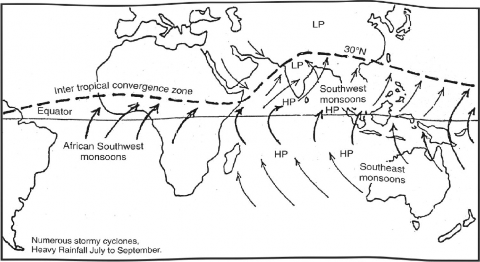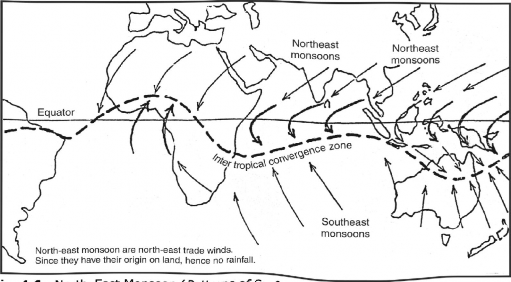The Dynamic Concept by Flohn
The dynamic concept about the origin of monsoons was put forward by Flohn in 1951. According to this concept, monsoon is the result of seasonal migr ation of planetary winds and pressure belts. The Inter-Tropical Convergence Zone (ITCZ) is formed due to the convergence of north-east and south-east trade winds near the equator. The northern and the southern boundaries of the ITCZ are called N1TC (Northern Inter-Tropical Convergence) and SITC (Southern Inter- Tropical Convergence) respectively. There is a belt of doldrums within the Inter-Tropical Convergence, characterised by equatorial westerlies. At the time of the summer solstice (21st June), when the Sun’s rays are vertical over the Tropic of Cancer, the NITC is extended up to 30° N latitude, covering South and south- east Asia. Thus, equatorial westerlies are established over these areas. The equatorial westerlies become south-west or summer monsoons. On a rotating earth, the trade winds of the Southern Hemisphere after crossing the equator turn towards their right (Coriolis effect) (Fig. 4.5). The NITC is associated with numerous atmospheric storms (cyclones) which yield heavy rainfall during wet monsoon months (July to September). Similarly, the north-east or winter monsoon

Fig. 4.5 South-West Monsoon (Patterns of Surface Monsoon Winds in July (Summer))
does not originate only due to low pressure in the Southern Hemisphere during winter solstice (when the Sun’s rays are vertical over the Tropic of Capricorn). In fact, the north-east monsoons are north-east trade winds which are re-established over south-east Asia due to southward shifting of pressure and wind belts. It is obvious that due to southward movement of the Sun at the time of winter solstice, the NITC is withdrawn from over south and south-east Asia, and north-east trade winds occupy their normal position. These north east trades, thus, become winter monsoons. The north-east monsoons having their origin on land are generally dry and devoid of rains (Fig. 4.6).

Fig. «.b iNorrn-tasr monsoon patterns or surface Monsoon Winds in January (Winter))
In brief, according to Flohn, the existence of monsoons in Asia, especially in the subcontinent of India, is not due to temperature contrasts between land and sea, but mainly due to the annual migration of thermally produced planetary winds and pressure belts. Despite the relative shifting oi Inter-Tropical Convergence (thermal equator) and pressure belts, Flohn seems to have ignored the upper atmospheric circulation (jet streams) and the southern oscillation, which make the Asiatic monsoon a fairly complex system. lie also could not explain the causes of early arrival of Indian monsoons in the states of north-east India. The dynamic concept, therefore, was also not taken as the sole explanation of the origin of monsoons.
